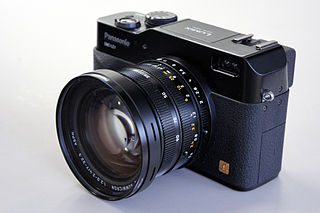
Lumix is Panasonic's brand of digital cameras, ranging from pocket point-and-shoot models to digital SLRs.

The Lumix DMC-L1 is Panasonic's first DSLR camera, and was announced in February 2006. This camera adheres to the Four Thirds System lens mount standard, making it the first non-Olympus Four Thirds camera, and thus confirming that the Four Thirds System is a semi-open standard such that compatible camera bodies can be built by different companies.
The Panasonic Lumix DMC-FZ7 is a six megapixel superzoom bridge digital camera that utilizes Panasonic's Venus II Engine. It features a 12× zoom lens and several modes of operation. It was replaced in 2007 by the DMC-FZ8

The Lumix DMC-L10 is Panasonic's second digital single-lens reflex camera (DSLR), a follow-up to the previous Lumix DMC-L1 model. It was announced in August 2007, and, like the Lumix DMC-L1, this model uses the Four Thirds System lens mount standard and contains some basic parts provided by Olympus.

The Panasonic Lumix DMC-TZ3 was a compact 'Travel Zoom' camera announced on January 31, 2007. It was the successor to the 2006 TZ1 announced in 2006, and was released in parallel with the TZ2. It has a 10× optical zoom with the focal range equivalent to 28–280 mm coupled with Mega O.I.S. image stabiliser. It is a fully automatic compact camera, without manual control of aperture and shutter time. The TZ3 was awarded both the TIPA "Best Superzoom Digital Camera" award and the EISA "European Compact Camera" award in 2007. The TZ4, TZ5, and TZ50 succeeded the TZ2 and TZ3.
Panasonic Lumix DMC-FX150 is a digital camera by Panasonic Lumix. The highest-resolution pictures it records is 14.7 megapixels, through its 28-100mm Leica DC VARIO-ELMARIT.
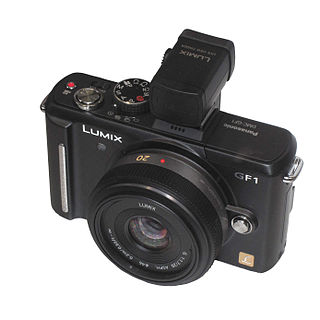
Panasonic Lumix DMC-GF1 was introduced in September 2009 as the third camera in Panasonic's Lumix G-series, using the Micro Four Thirds system. It was the first model in the "GF" line, which is primarily distinguished from the other Lumix G cameras by the lack of an integrated electronic viewfinder.
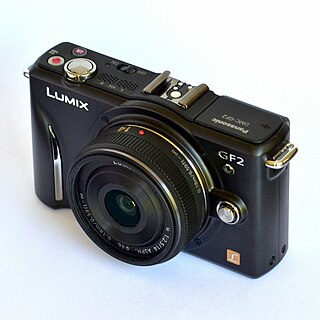
Panasonic Lumix DMC-GF2 is the sixth camera in Panasonic's Lumix G-series, using the Micro Four Thirds System.

The Panasonic Lumix DMC-GH2 is a digital camera with HD video recording capability that is part of the Micro Four Thirds system. Though commonly referred to as a DSLR camera, it has no mirror or optical viewfinder, but has instead both a fold-out LCD screen and a electronic viewfinder.
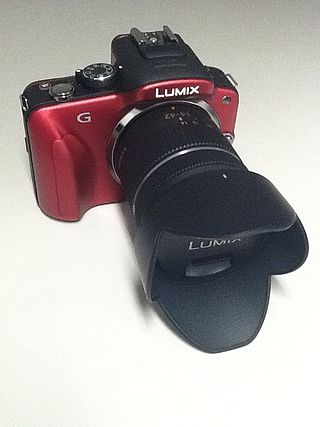
The Panasonic Lumix DMC-G3 is a digital mirrorless interchangeable lens camera adhering to the joint Olympus and Panasonic Micro Four Thirds System (MFT) system design standard. The Panasonic Lumix DMC-G3 is the eighth Panasonic MFT camera introduced under the standard and the thirteenth model MFT camera introduced by either Olympus or Panasonic, as of the G3 product announcement date.

The Panasonic Lumix DMC-G2 is a digital mirrorless interchangeable lens camera that adheres to the Micro Four Thirds System (MFT) design standard developed by Olympus and Panasonic. It was announced by Panasonic in March 2010 along with the Lumix DMC-G10. The G2 was introduced as the successor to the Lumix DMC-G1 camera, with upgrades such as 720p high-definition video recording capability in AVCHD Lite and Motion JPEG formats.
The Panasonic Lumix DMC-G10 is the sixth digital mirrorless interchangeable lens camera introduced that adheres to the Micro Four Thirds System (MFT) system design standard, and the fourth Panasonic model MFT camera. The G10 model was announced concurrently with its more capable sibling, the Panasonic Lumix DMC-G2, in March 2010.

Panasonic Lumix DMC-GF3 is the eighth camera in Panasonic's Lumix G-series adhering to the Micro Four Thirds System (MFT) design standard, and was announced in June 2011.

The Panasonic Lumix DMC-GX7 announced in August 2013, is a Micro Four Thirds compact mirrorless interchangeable lens camera. It was Panasonic's first Micro Four Thirds camera with a built-in in-body stabilization system (IBIS) and has a built-in EVF. Panasonic uses 2-axis in-body stabilization allowing the use of shutter speeds 1 to 2 stops slower than without stabilization, compared to the 4 to 5 stops of improvement offered by Olympus' 5-axis stabilization.
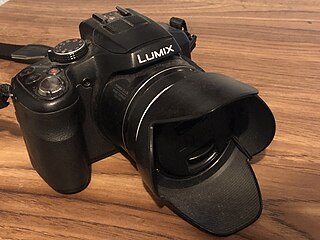
Panasonic Lumix DMC-FZ200 is a digital camera by Panasonic Lumix, which was announced in July 2012. The highest-resolution pictures it records is 12.1 megapixels, through a 25 mm Leica DC Vario-Elmarit.

Panasonic Lumix DMC-GF6 is a Micro Four Thirds digital camera by Panasonic Lumix with a 16 megapixel resolution sensor. It is the successor to the GF5. The GF6 adds Wi-Fi with NFC, a 180 degree tilting screen and a mode dial with a customizable lever. It also has an improved grip and better ISO performance when compared to its predecessor. It comes bundled with the new Panasonic Lumix G Vario 14-42mm f/3.5–5.6 II Asph., Mega O.I.S., which boasts better build quality, a smaller design and improved sharpness.
Panasonic Lumix DMC-SZ1 is a digital camera by Panasonic Lumix. The highest-resolution pictures it records is 16.6 megapixels, through its 25mm Wide-Angle Leica DC VARIO-ELMAR.

The Panasonic Lumix DMC-FZ1000 is a digital superzoom bridge camera by Panasonic. It went on sale in June 2014. It has a 20 megapixel 3:2 BSI-CMOS sensor and Leica-branded 25–400 mm equivalent focal length lens with a maximum aperture of f/2.8 to f/4. It has a 1-inch CMOS sensor and supports ISO film speeds from 80 to 25600, shutter speeds from 1/16000 s to 60 s and RAW capture, while the lowest physical shutter speed is 1/4000 s. The unit is equipped with five "Fn" function buttons which can be allocated to custom shortcuts.

The Panasonic Lumix DMC-LX100 is a compact camera with a 13 MP Four Thirds type 17.3mm x 13mm sensor announced by Panasonic on September 15, 2014. LX100 features an F1.7-2.8 24-75mm equivalent Leica-branded lens, 2764k dot Electronic viewfinder, 3" 921k dot LCD, built-in wireless and it can record 4K video at 30p or Full HD at 60p.



















